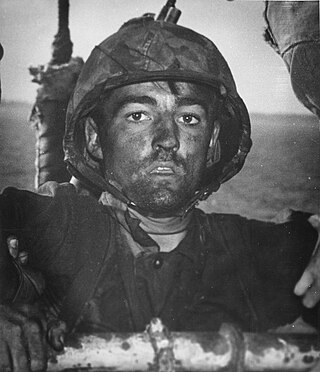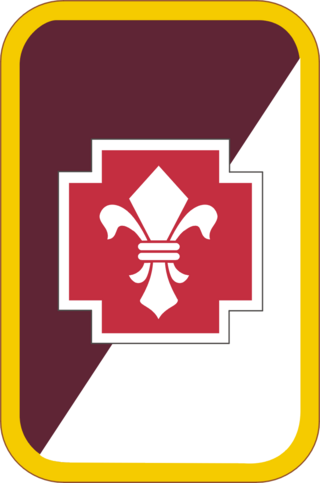Related Research Articles

A Vietnam veteran is an individual who performed active military, naval, or air service in the Republic of Vietnam during the Vietnam War.

A veteran is a person who has significant experience and expertise in a particular occupation or field. A military veteran is a person who is no longer in a military.

The United States Army Special Operations Command (Airborne) (USASOC ( YOO-sə-sok)) is the command charged with overseeing the various special operations forces of the United States Army. Headquartered at Fort Liberty, North Carolina, it is the largest component of the United States Special Operations Command. It is an Army Service Component Command. Its mission is to organize, train, educate, man, equip, fund, administer, mobilize, deploy and sustain Army special operations forces to successfully conduct worldwide special operations.

The U.S. Army Medical Command (MEDCOM) is a direct reporting unit of the U.S. Army that formerly provided command and control of the Army's fixed-facility medical, dental, and veterinary treatment facilities, providing preventive care, medical research and development and training institutions. On 1 October 2019, operational and administrative control of all military medical facilities transitioned to the Defense Health Agency.

Combat stress reaction (CSR) is acute behavioral disorganization as a direct result of the trauma of war. Also known as "combat fatigue", "battle fatigue", or "battle neurosis", it has some overlap with the diagnosis of acute stress reaction used in civilian psychiatry. It is historically linked to shell shock and can sometimes precurse post-traumatic stress disorder.

Psychiatric and mental health nurses in the U.S. Army Nurse Corps employing groundbreaking protocols and treatments in psychiatric issues to address the unique challenges that our service men and women face, more commonly post-traumatic stress disorder and traumatic brain injuries. Most people understand that trauma exposure is a popular occupational hazard for military members. Psychiatric screenings, before and during their enlistment, and treatments after being exposed to warfare, death, destruction, and torture have been extremely beneficial for military personnel and their dependents.

The 13th Sustainment Command (Expeditionary)—the "Lucky 13th"—is a U.S. Army modular sustainment command which serves as a forward presence for expeditionary operations for a theater, or in support of a regional combatant commander. Expeditionary sustainment commands (ESC), such as the 13th, synchronize distribution of supplies and services within their operational areas and provides distribution oversight. Formed at Fort Cavazos, Texas when the 1st Logistics Command deployed to Vietnam, the organization then known as the 13th Support Brigade was initially responsible for the training of technical services units to assume combat service support missions in Southeast Asia.

The Alaska Army National Guard is a component of the United States Army and the Alaska Department of Military and Veterans Affairs. Along with the Alaska Air National Guard, it makes up the Alaska National Guard. Alaska Army National Guard units are trained and equipped as part of the United States Army. The same ranks and insignia are used and National Guardsmen are eligible to receive all United States military awards. The Alaska Guard also bestows a number of state awards for local services rendered in or to the state of Alaska.

The United States Army Armor School is a training school located at Fort Moore, Georgia. Its primary focus is the training of United States Army soldiers, non-commissioned officers, warrant officers, and commissioned officers. It also trains for equipment handling, including the M1 Abrams, the Bradley Fighting Vehicle, and the Stryker Mobile Gun System. The Armor School moved to Fort Benning in 2010 as part of the United States Base Realignment and Closure program.

The Madigan Army Medical Center, located on Joint Base Lewis-McChord just outside Lakewood, Washington, is a key component of the Madigan Healthcare System and one of the largest military hospitals on the West Coast of the United States.

The 62nd Medical Brigade, formerly the 62nd Medical Group of the United States Army is a unit of the Army Medical Department and I Corps and Fort Lewis. It is based entirely at Joint Base Lewis-McChord, Washington. Currently, the brigade is commanded by Colonel Robert S. Heath, the first Physican Assistant in history to command a US Army medical brigade, and Command Sergeant Major Michael P. Morrill.
Military psychiatry covers special aspects of psychiatry and mental disorders within the military context. The aim of military psychiatry is to keep as many serving personnel as possible fit for duty and to treat those disabled by psychiatric conditions. Military psychiatry encompasses counseling individuals and families on a variety of life issues, often from the standpoint of life strategy counseling, as well as counseling for mental health issues, substance abuse prevention and substance abuse treatment; and where called for, medical treatment for biologically based mental illness, among other elements.

Military psychology is a specialization within psychology that applies psychological science to promote the readiness of military members, organizations, and operations. Military psychologists provide support to the military in many ways, including through direct clinical care, consultation to military commanders, teaching others and supporting military training, and through research relevant to military operations and personnel. Military psychology as a field has been growing since the early 20th century, evidence that the demands and needs for psychological clinical and operational application is continuing to grow steadily. There are many stressors associated with military service, including exposure to high-risk training and combat. As such, psychologists are critical support components that assist military leaders in designing appropriate training programs, providing oversight to those programs, and assisting military members as they navigate the challenges of military training and their new lifestyle. Military psychology covers a wide range of fields throughout the military including operational, tactical, and occupational psychology. Gender differences between military-trained personnel who seek mental health assistance have been extensively studied. Specific examples include post traumatic stress disorder (PTSD) associated with combat, or guilt and family/partner difficulties accompanying extended or frequent deployments due to separation. Clinical providers in military psychology are often focused on the treatment of stress, fatigue, and other personal readiness issues. Previous wars such as the Korean war, Vietnam war, and WW 2 provide great insight to the workings and practices of military psychology and how the practices have changed and assisted the military over the years.

The Army Wounded Warrior Program (AW2) is the official U.S. Army program that assists and advocates for severely wounded, ill or injured Soldiers, Veterans, and their Families and Caregivers, wherever they are located, regardless of military status. Soldiers who qualify for AW2 are assigned to the program as soon as possible after arriving at the Warrior Transition Unit (WTU). AW2 supports these Soldiers and their Families throughout their recovery and transition, even into Veteran status. Through the local, personalized support of AW2 Advocates, AW2 strives to foster the Soldier's independence. There are more than 20,000 severely wounded, ill and injured Soldiers and Veterans currently enrolled in AW2.

The Persian Gulf War syndrome is a chronic and multi-symptomatic disorder affecting military veterans of both sides of the Gulf War (1990–1991). A wide range of acute and chronic symptoms have been linked to it, including fatigue, muscle pain, cognitive problems, insomnia, rashes and diarrhea. Approximately 250,000 of the 697,000 U.S. veterans who served in the Gulf War have enduring chronic multi-symptom illness, a condition with serious consequences.

The Millennium Cohort Study is an ongoing longitudinal cohort study headquartered at the Naval Health Research Center in San Diego, California and designed to evaluate any long-term health effects of military service, including deployments. It is the largest population-based prospective health project in US military history, currently collecting data on over 200,000 enrolled participants. Investigators that conduct the Millennium Cohort Study include uniformed and non-uniformed scientists from the Army, Navy, Air Force, Department of Veterans Affairs and academic institutions.
The Naval Center for Combat and Operational Stress Control (NCCOSC) is a U.S. Navy Medicine organization established to promote psychological health in the U.S. Navy and Marine Corps. It is a culturally relevant center that leverages sound medical knowledge to improve resilience, preserve psychological health, improve care for sailors, marines and their families and facilitate Navy Medicine research efforts on psychological health and traumatic brain injury.

Comprehensive Soldier Fitness (CSF) was established in August 2008 by then-Chief of Staff of the United States Army, General George W. Casey, Jr., in an effort to address the challenges being faced due to multiple deployments required by persistent conflicts in Iraq and Afghanistan. Instead of focusing only on treatment after the issues arose, Casey wanted to also provide preventative measures to the soldiers, their families and Army civilians to make them stronger on the front end. CSF Resilience Training was created to give these individuals the life skills needed to better cope with adversity and bounce back stronger from these challenges. Renamed in October 2012 as Comprehensive Soldier and Family Fitness (CSF2), was designed to build resilience and enhance performance of the Army family—soldiers, their families, and Army civilians. Comprehensive Soldier Fitness is not a treatment program in response to adverse psychological conditions. CSF2 has three main components: online self-development, training, and metrics and evaluation. According to Army Regulation 350–53, to be published December 2013, the following are the Vision, Mission and components of CSF2:
An important part of the heritage of family resilience is the concept of individual psychological resilience which originates from work with children focusing on what helped them become resilient in the face of adversity. Individual resilience emerged primarily in the field of developmental psychopathology as scholars sought to identify the characteristics of children that allowed them to function "OK" after adversity. Individual resilience gradually moved into understanding the processes associated with overcoming adversity, then into prevention and intervention and now focuses on examining how factors at multiple levels of the system and using interdisciplinary approaches promote resilience. Resilience also has origins to the field of positive psychology. The term resilience gradually changed definitions and meanings, from a personality trait to a dynamic process of families, individuals, and communities.
The Combat Stress Intervention Program (CSIP) is a 3-year United States Department of Defense-funded research program to study mental health issues experienced by veterans returning from Operation Iraqi Freedom and Operation Enduring Freedom. The $1.5 million study, which is managed under the Military Operational Medicine Research Program, focuses on Combat Stress Disorder, Posttraumatic stress disorder, and other post-deployment transitional challenges. The study also focuses on developing resources and solutions for such veterans.
References
- 1 2 "Battlemind Information". U.S. Army Medical Command. May 15, 2008. Archived from the original on 29 May 2008. Retrieved May 22, 2008.
- ↑ Crosbie E. Saint (1992). Battlemind guidelines for battalion commanders. Headquarters, U.S. Army, Europe and Seventh Army.
- ↑ Julia M. Whealin; Lorie T. DeCarvalho; Edward M. Vega (2008). Clinician's Guide to Treating Stress After War: Education and Coping Interventions for Veterans. Wiley. ISBN 978-0-470-25777-7.
- ↑ Julia M. Whealin; Lorie T. DeCarvalho; Edward M. Vega (2008). Strategies for Managing Stress After War: Veteran's Workbook and Guide to Wellness. Wiley. ISBN 978-0-470-25776-0.
- ↑ Huseman, Susan (Jan 3, 2008). "'Battlemind' Prepares Soldiers for Combat, Returning Home". defenselink.mil. Archived from the original on 20 May 2008. Retrieved May 22, 2008.
- ↑ Scott, Larry. "A LOOK AT DoD's "BATTLEMIND" PROGRAM". VA Watchdog. Archived from the original on March 27, 2008. Retrieved May 22, 2008.